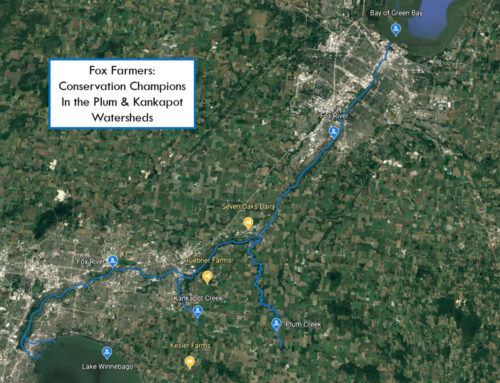Producers, agronomists and agriculture industry experts shared common ground with state representatives, county board members and other stakeholders at Congressman Mike Gallagher’s annual Save the Bay field day on May 30.
The focus of the hands-on field day was to shed light on new innovations in farming and nutrient management practices that build soil health and keep excess nutrients and sediment from entering the waterways in Northeast Wisconsin.
The first stop was at the manure compost pile on the Dennis Christoph Farm near Luxemburg. Kevin Erb, Conservation Training Coordinator at UW Extension, led the conversation noting that composting is a viable alternative for many farms that want to address the manure issue in a different way. Erb explained, “Composting is creating the perfect environment for oxygen-using bacteria to convert manure into topsoil without the odors typically found on a dairy farm. Properly done, composting reduces manure volume by more than 50 percent, eliminates most pathogens, and creates a sustainable soil amendment.”
Farther down the road near Kewaunee, Deer Run Dairy owners Dale Bogart and Duane Ducat explained how the dairy manages manure volume and reduces odor and pathogens through its methane digester. Field day participants had opportunity to see how manure is processed and converted into 500 kw energy that is then returned to the grid. With more than 100 anaerobic digesters across the state, AD systems help support Wisconsin’s position as a leader in dairy and cheese production.
Moving from manure to soil health, USDA-NRCS technical staff and agronomists explained new strategies in no-till and cover crops that build up, rather than break down, soils. The visual learners in the group appreciated the rainfall simulator demonstration. “The simulator enables producers to get a close-up, side-by-side comparison of how different field managements handle a rainfall event,” explained Barry Bubolz, USDA-NRCS GLRI coordinator. “Runoff can be decreased and infiltration increased with conservation practices such as no-till planting and cover crops.”
The Vande Wettering Farm in Greenleaf hosted the afternoon portion of the field day. Owners Bill and Tom Vande Wettering have dedicated a number of acres on their farm for grazing. Adam Abel, USDA-NRCS, explained the farm’s grazing strategy. According to Abel, “Rotational grazing is a win-win conservation practice. Producers can reduce feed and labor cost while growing a healthy animal – this is in addition to the conservation benefits of reduced soil erosion, improved water quality and increased infiltration.”
As the group trekked across a field of corn and clover, Fox Demonstration Farm Network coordinator Brent Peterson noted successes and setbacks of the farm’s cover crops. Outagamie and Brown Land and Water Conversation staff Andy Kiefer and Nick Peltier were on hand to demonstrate how toolbars were retrofitted on equipment to accommodate conservation planting. According to Peltier, “GLRI funding has allowed us the opportunity to have innovative equipment available for farmers to try on their farms. This equipment demonstrates different ways to plant cover crops, no-till plant cash crops, and apply manure during the growing season or to established cover crops. Some of these new concepts require innovative equipment that, without this opportunity, farmers in the area may not be able to try these practices.” The counties share interseeders, no-till planters, manure injectors and other equipment farmers can borrow to test on their farms.
The Vande Wettering Farm has also set aside acres for wetland restoration. Field day participants learned the differences between a wetland restoration and a wetland treatment basin programs from Gary Van Vreede, US Fish & Wildlife, and Jeremy Freund, Outagamie County Land and Water.
A number conservation farming practices are relatively new; thus, gathering data on soil and water quality impacts is part of the process. Multiple partners are working together to monitor the impacts of conservation actions on the quality of water leaving farm fields, to the quality of water entering Green Bay from the Fox River. Ben Young, USGS, highlighted the function of the farm’s edge-of-field water quality monitoring station, and UW-GB Professor Kevin Fermanich shared results and where other stations are located throughout Northeast Wisconsin. According to Fermanich, “It is critical that the water is tested at multiple spatial scales and at short and long-term frequencies. This type of testing allows us to better understand the impacts of conservation actions and year-to-year variability on stream, river and bay water quality.” He added, “We expect to see reductions in phosphorus runoff when manure and other nutrient applications more closely match the amount crops need and when the crops need it. Through time, reducing the amount of fall applied manure should translate to measurements of improved water quality. We are just starting to see the impacts of practices that protect the soil, such as cover crops, on the quality of runoff water.”
For field day photos, equipment list, water quality monitoring sites and other documents, visit Gallagher.house.gov and click on the “Issues” tab, or call 920.903.9806.
Contributed by Save the Bay.








